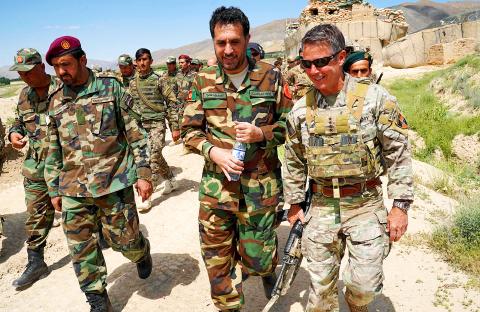Only a tangle of razor wire marks the entrance of a remote Afghan army checkpoint that might soon be shuttered as the government closes vulnerable outposts after years of losses to Taliban fighters and desertions.
The post in Wardak Province west of Kabul has been hit before, and its sagging blast walls and teetering sandbags make clear the vulnerability of the 13 troops living there for weeks on end.
Now, after years of brutal attacks and mass desertions from similar checkpoints, the Afghan government is acting on long-standing US requests to close them.

Photo: AFP
The aim is to shutter outposts where troops are often left like sitting ducks for Taliban attackers and consolidate them onto larger bases — several of which are under construction.
The plan is for troops to lead offensive missions, taking the fight to the Taliban instead of trying to survive day-to-day in often deplorable living conditions with little outside support.
The “checkpoint is a failed tactic,” Afghan Army General Dadan Lawang said recently at a US base in Paktia Province, south of Kabul.
About 50 percent of military casualties occur at checkpoints, he said, a grim number considering tens of thousands of Afghan troops have been killed or wounded since the end of 2014 — losses the massively depleted Afghan military can ill afford.
“We want to draw down all those checkpoints and establish strong bases now,” Lawang said.
The idea of closing checkpoints has been taboo in Afghan politics for years.
A tiny fort flying the black-red-and-green national flag sends a message that the government holds an area, and Afghan politics is built on a patchwork of alliances with regional power brokers, many of them in remote places.
“To maintain an alliance sufficient to remain in office ... the president of Afghanistan has often preferred to push troops out into locations that make no military sense, but are politically important,” said Stephen Biddle, a professor at Columbia University in New York who has written extensively about Afghanistan.
US Army Brigadier General Kevin Admiral, who heads the US military’s Task Force Southeast, said it was challenging to finally change the Afghan military’s view.
“They have a lot of political pressure at the local level with district governors and parliamentarians who have said this is our only visible representation of [the government] in these remote areas,” he said.
For US General Scott Miller, who leads NATO’s Afghanistan mission and the US war effort in the country, the closure of checkpoints is crucial for the Afghan military.
“They don’t lose people in [offensive] operations, they kill Taliban,” Miller told US military officials at a recent meeting. “You want to hear my [tactical] priorities? Talk about checkpoints.”
To hammer his message, Miller makes frequent trips across Afghanistan, bringing local military commanders to show them troops’ living conditions.
On a visit last week to the Wardak checkpoint, Miller said he wanted to open Afghan commanders’ eyes to the perilousness of such outposts.
The camp, where troops sleep in converted shipping containers with smashed windows, is a short distance from Highway 1 — a key route for sending goods and supplies into Kabul and around the country.
However, despite its strategic location, troops at the checkpoint and others like it often go without regular food or pay because of mismanagement and corruption.
On Miller’s visit, US snipers and soldiers secured the isolated facility’s perimeter and one Afghan soldier complained to his higher ups about not having been paid for three months.
Acting Afghan Minister of Defense Asadullah Khalid blamed a documentation issue and said it would be fixed.
His staff handed out several US$100 bills to soldiers from a wad that Khalid said was a gift for Eid al-Fitr, the festival marking the end of Ramadan.
“I want to make sure that everyone sitting on a checkpoint gets a paycheck and food,” Miller said. “It’s a leadership issue. These are things we take for granted.”
While critics agree Afghan checkpoints have little tactical value, they differ over whether withdrawing troops to bases will make them more willing to fight.

James Watson — the Nobel laureate co-credited with the pivotal discovery of DNA’s double-helix structure, but whose career was later tainted by his repeated racist remarks — has died, his former lab said on Friday. He was 97. The eminent biologist died on Thursday in hospice care on Long Island in New York, announced the Cold Spring Harbor Laboratory, where he was based for much of his career. Watson became among the 20th century’s most storied scientists for his 1953 breakthrough discovery of the double helix with researcher partner Francis Crick. Along with Crick and Maurice Wilkins, he shared the

OUTRAGE: The former strongman was accused of corruption and responsibility for the killings of hundreds of thousands of political opponents during his time in office Indonesia yesterday awarded the title of national hero to late president Suharto, provoking outrage from rights groups who said the move was an attempt to whitewash decades of human rights abuses and corruption that took place during his 32 years in power. Suharto was a US ally during the Cold War who presided over decades of authoritarian rule, during which up to 1 million political opponents were killed, until he was toppled by protests in 1998. He was one of 10 people recognized by Indonesian President Prabowo Subianto in a televised ceremony held at the presidential palace in Jakarta to mark National

LANDMARK: After first meeting Trump in Riyadh in May, al-Sharaa’s visit to the White House today would be the first by a Syrian leader since the country’s independence Syrian President Ahmed al-Sharaa arrived in the US on Saturday for a landmark official visit, his country’s state news agency SANA reported, a day after Washington removed him from a terrorism blacklist. Sharaa, whose rebel forces ousted long-time former Syrian president Bashar al-Assad late last year, is due to meet US President Donald Trump at the White House today. It is the first such visit by a Syrian president since the country’s independence in 1946, according to analysts. The interim leader met Trump for the first time in Riyadh during the US president’s regional tour in May. US envoy to Syria Tom Barrack earlier

US President Donald Trump handed Hungarian Prime Minister Viktor Orban a one-year exemption from sanctions for buying Russian oil and gas after the close right-wing allies held a chummy White House meeting on Friday. Trump slapped sanctions on Moscow’s two largest oil companies last month after losing patience with Russian President Vladimir Putin over his refusal to end the nearly four-year-old invasion of Ukraine. However, while Trump has pushed other European countries to stop buying oil that he says funds Moscow’s war machine, Orban used his first trip to the White House since Trump’s return to power to push for